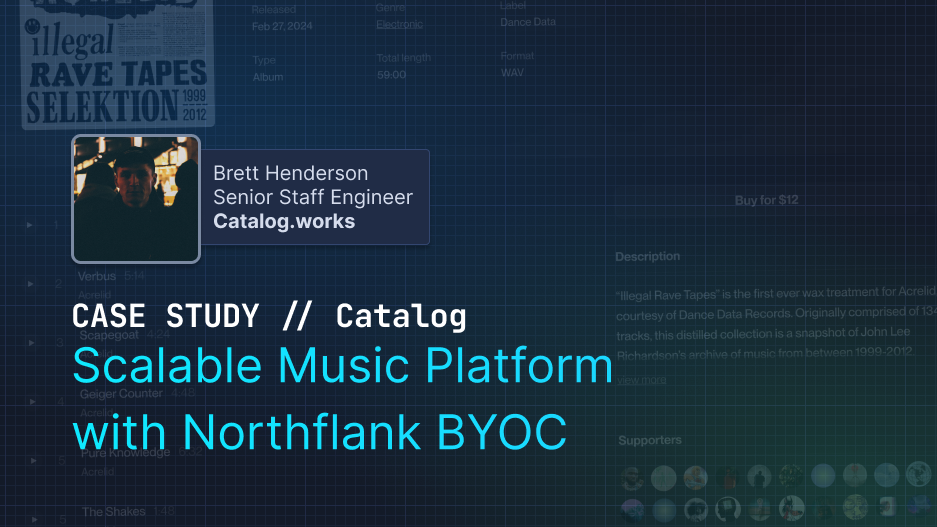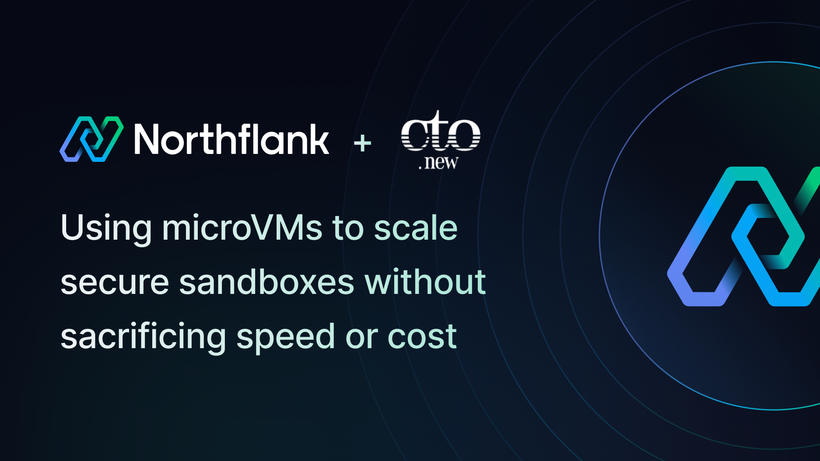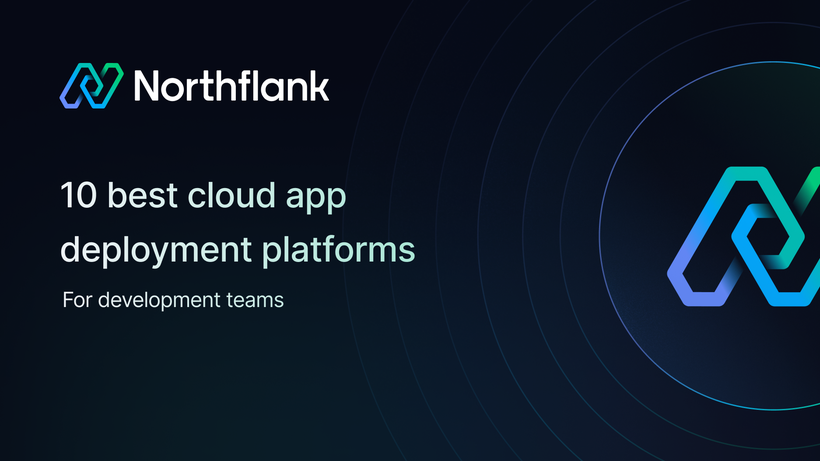

Case Study: How Catalog Built a Scalable Streaming Music Platform with Northflank
Catalog set out to revolutionize how artists connect with fans. They’re creating a self-publishing and audience engagement platform with a next-generation music streaming service and internet radio channels.
The challenge? Building a highly flexible, developer-friendly backend that could support complex workloads. Their services relied on CPU-intensive transcoding, high-bandwidth streaming (HLS), and multi-node read-write (RWX) volumes. They needed all of this while leveraging existing cloud credits and maximizing developer efficiency.
With Northflank, Catalog found an ideal alternative to traditional PaaS offerings like Heroku, Render, and Railway. They also found Northflank a more robust and approachable solution than managed services like Google Cloud Run or raw Google Kubernetes Engine (GKE).
We spoke with Brett Henderson, Senior Staff Engineer at Catalog, about his experience with Northflank.
“I’ve never had this level of interaction with any other vendor really. I’ve never gotten to work with them this closely. It’s not even comparable with anyone else. I don’t actually think we would have been able to release the product that we did without Northflank in any sort of comparable timeline.”

An image of Catalog’s site showing how they help artists self-publish and engage directly with listeners.
By harnessing Northflank’s managed Kubernetes platform, Catalog unlocked a polyglot, self-service infrastructure. Northflank provided significantly simplified complex CI/CD pipelines, ensured high availability for HLS media streaming, leveraged BYOC (Bring Your Own Cloud) to utilize existing cloud credits, and integrated tightly with advanced CDN and logging solutions like Fastly.
Catalog’s specialized streaming workloads quickly revealed the limitations of conventional PaaS platforms.
- Complex CI/CD Requirements and Self-Service DevOps: Catalog’s engineers wanted a platform that automated their DevOps, integrated seamlessly with GitOps workflows, and eliminated the complexity of manually managing Kubernetes. They also sought a solution that offered a simple, self-service UI without sacrificing power.
- ReadWriteMany (RWX) Volumes for Shared Storage: Few PaaS solutions support RWX volumes, essential for running CPU-intensive transcoding workloads in parallel while sharing common storage. Without RWX, scaling a streaming service becomes inefficient and expensive. RWX allows for horizontal scaling of a stateful workload that traditionally couldn’t be scaled horizontally.
- HLS (HTTP Live Streaming) Support: HLS is adaptive bitrate streaming for high-quality, near-lossless audio. Most legacy PaaS providers lack first-class support for media streaming protocols like HLS, making it difficult to serve large audiences at low latency.
- Advanced Fastly and CDN Integration for Listener Metrics: Catalog leverages Fastly as their CDN for distributing audio streams. To accurately track listener counts, session data, and geographical distribution, they needed a solution that could easily pipe CDN logs into their observability stack.
- Polyglot and Specialized Stacks: Catalog’s backend stack is diverse. It features stacks like TypeScript + Bun and domain-specific languages like LiquidSoap (OCaml-based) for streaming logic. The team needed a platform that didn’t lock them into a single language or framework.
- Needed to run on their own cloud account: Catalog wanted to run workloads in their own cloud. It was too hard to do with the tools provided by Google. They needed BYOC to make use of cloud credits and to configure infrastructure to the unique requirements of a media streaming app. BYOC was required for performance, so their data stayed close to their compute for transcoding and serving music streams efficiently. A single cloud interface like BYOC was also necessary so developers could move fast and unlock self-service while keeping the guard rails on for safety. Finally, BYOC and Northflank as the abstraction, Catalog could avoid the tax of training all of their developers to implement and run Kubernetes at scale.
After evaluating various Kubernetes-based developer platforms and PaaS alternatives, Catalog selected Northflank. They found a managed Kubernetes platform that combines the flexibility of raw Kubernetes with an intuitive developer experience. For Brett, he found this was exactly what his team needed.
“Anyone who’s messed with Kubernetes before knows it’s not easy to work with. With Northflank, I didn’t have to dedicate time to managing the cluster while building our product. The managed Kubernetes experience made everything real easy.”
- Managed Kubernetes + BYOC: Catalog needed a number of things from BYOC. Things like better DX / UX for their devs to self-serve, more locality and control over their data, and improved automation of day 2 operations. They also needed to leverage their existing ~$100k Google Cloud Startup Program credits. Northflank’s Bring Your Own Cloud (BYOC) approach allowed them to use GKE while layering an easy-to-use interface, CI/CD, cluster management, and workflow automation on top.
- Support for Specialized Workloads (HLS & RWX): Unlike traditional PaaS providers, Northflank supports complex workloads like HLS streaming and ReadWriteMany volumes. By combining the simplicity of a next-gen PaaS with the power of Kubernetes, Northflank eliminated the “graduation problem” that often arises when startups outgrow their initial platforms.
- Developer Experience and Self-Service Infrastructure: Catalog needed integrated build pipelines and GitOps workflows. That’s exactly what they got with Northflank. Without needing to touch raw YAML Catalog’s team could connect their GitHub repo, define workloads, and start deploying quickly. This eliminated the need for multiple standalone tools and reduced the complexity of their release process.
- Polyglot Workloads and Unique Stacks: Catalog’s stack spanned everything from TypeScript + Bun for their web framework to LiquidSoap (an OCaml-based DSL) for streaming logic. Northflank’s flexible build system and language-agnostic approach made it straightforward to spin up workloads regardless of the runtime or framework.
- Advanced CDN & Fastly Log Integration: Streaming made Catalog’s CDN setup a challenge. They needed a log sink to seamlessly route CDN logs from Fastly. Northflank’s log sink integration granted them access to real-time analytics on listener counts, geographic data, and engagement metrics. This not only simplified understanding their listener metrics, but also allowed them to build real-time dashboards showing how many users were tuning in and where they were located geographically.
By adopting Northflank as their Kubernetes-based developer platform, Catalog saved significant time and reduced operational complexity. According to Brett Henderson, Senior Staff Engineer at Catalog, Northflank saved an estimated six months of engineering time, or a little over 1000+ hours. Instead of wrestling with fragmented tooling or spinning up custom Kubernetes operators, the team could focus on innovation and rapid feature delivery.
“The developer experience is great. Working with Northflank is easy, and their proactive support is unmatched. It’s so developer-friendly and technical, without being overly complex like a typical cloud dashboard.”
With Northflank Catalog has the freedom to iterate on new streaming features, handle scaling demands, and maintain top-tier performance for their HLS streams. The platform unlocked integrations with Fastly, support for advanced caching and logging strategies, and the ability to run on any cloud.
Northflank means Catalog can continue growing their streaming service without hitting operational roadblocks.
With their streaming platform in production and performing at scale, Catalog plans to continue iterating and improving their platform on Northflank. They are confident that as they continue to iterate Northflank will remain a stable, flexible platform that helps them innovate quickly.
If you’re looking to streamline your complex Kubernetes deployments, enhance CI/CD, or leverage your own cloud credits then Northflank is here to help.
Contact Us to learn how Northflank can help you conquer complexity, streamline deployments, and deliver exceptional developer experiences.



